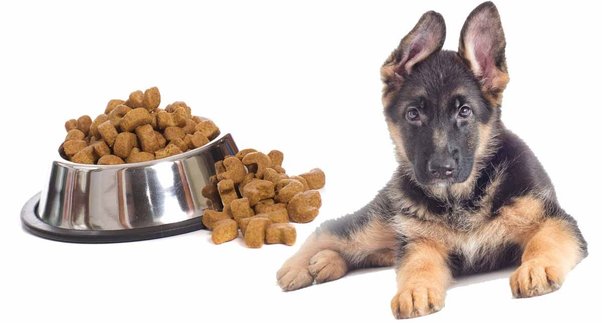Choosing the best dog food for labradoodles

For your Labradoodle’s health and pleasure, selecting a dog food that provides an optimal mix of nutrients is crucial. As a hybrid of Labrador Retrievers and Poodles, Labradoodles have special dietary requirements. No matter your dog’s age, picking the right diet is essential for its growth and health.
Providing a balanced diet of high-quality dry dog food is important to ensure your Labradoodle is healthy and happy throughout its life. Choosing the best dog food from the many brands available can be difficult, but you can do it with the knowledge you need.
5 Best dog food for labradoodles
1. Diamond
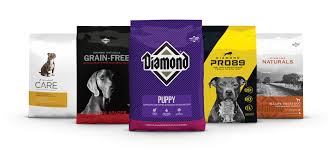
Main Ingredients: chicken, chicken stock, chicken liver, rice flour, carrots..
The Diamond Naturals range features three wet recipes, the most notable of which is Diamond Chicken Dinner for Adult Dogs and Puppies. Chicken provides most of the protein for this meal. About 74% fat and 43.2% protein are in it, with 31.8% fat and 17% estimated carbs making up the dry matter analysis.
- Primary Substances
- Category: No grains
- Nutritional Content 43.2%
- Standards set by AAFCO Free of grains
- Ideal for Canines and Puppies
2. The Kirkland

Main Ingredients: Canola oil, sweet potatoes, peas, potatoes, and turkey dinner.
A Signature by Kirkland The Kirkland Nature’s Domain range includes six dry recipes, one of which is Turkey and Sweet Potato from Nature’s Domain. Turkey provides most of the protein for this product. The recipe’s dry matter analysis reveals a protein-to-fat ratio of approximately 58%, with fat making up 15.6% of the total and carbs accounting for 49.8%.
- Patina Decayed
- Primary Substances
- Category: No grains
- Nutritional Content 26.7%
- AAFCO Guidelines for Every Stage of Life
- Ideal for Canines and Puppies
3. The Ollie
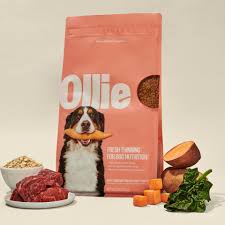
Main Ingredients: beef, potatoes, peas, carrots, and beef kidneys.
The Ollie Fresh product line includes four dishes, including Ollie Beef Dish with Sweet Potato. The recipe’s animal protein comes primarily from beef. The recipe’s dry matter analysis shows that the protein-to-fat ratio is approximately 78%, with protein making up 32.1% of the total, fat 25%, and carbohydrates 34.9%.
- Condition Recent
- Natural, unprocessed
- Volume of Protein 32.1 percent
- AAFCO Guidelines for Every Stage of Life
- Ideal for Canines and Puppies
4. Wellness
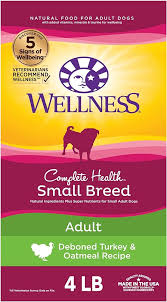
Main Ingredients: beef, potatoes, peas, carrots, and beef kidneys.
The Wellness Complete Health product range includes eight wet recipes, one of which is the Wellness Turkey & Sweet Potato Formula. Turkey provides most of the protein. The recipe’s dry matter analysis shows that the protein-to-fat ratio is roughly 63%, with 36.4% protein, 22.7% fat, and 32.9% estimated carbs.
- Feel Damp
- Category: No grains
- Protein Content 36.4 percent
- All Life Stages (except larger dogs’ growth) AAFCO Standards
- Ideal for Canines and Puppies
5. Taste of the Wild
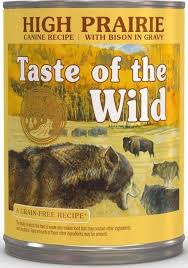
Main Ingredients: Primary Components Buffalo, lamb, peas, sweet potatoes, chicken.
Among Taste of the Wild’s High Prairie Canine Recipe’s nine dry recipes is one for Roasted Bison and Roasted Venison. Buffalo provides the bulk of the meat protein in this dish. The dry matter analysis shows that the dish has an estimated 36.4% carbs, 20% fat, and 35.6% protein, for a fat-to-protein ratio of around 56.
- Patina Decayed
- Category: No grains
- Volume of Protein 35.6%
- AAFCO Guidelines Upkeep
- Best for Canines
How to Make Sure Your Labradoodle Gets the Food?
Choosing the food for your Labradoodle is crucial to ensure their health and happiness. Whether you have a new puppy or an dog, selecting the right food can significantly impact their well-being. Here’s a guide to help you navigate the options and make the best choices for your furry friend in 2024.
Understanding Food for Your Labradoodle
Various options for your Labradoodle are available, including kibble, wet food, and grain-free choices. Each type has its benefits, and understanding them can help you decide what’s best for your dog.
Kibble vs. Wet Food
Kibble, or dry kibble, is popular with many dog owners. It’s convenient, easy to store, and helps clean your Labradoodle’s teeth. However, some dogs prefer the taste and texture of wet food, which can also provide additional hydration. It’s essential to observe how your Labradoodle responds to each type and adjust accordingly.
Grain-Free Options
In recent years, grain-free diets have gained popularity. Some Labradoodles may have food allergies or sensitivities to grains, making grain-free kibble a good option. However, it’s important to consult with your vet to ensure this diet suits your pet’s specific needs.
Addressing Allergies and Food Sensitivities
Labradoodles often experience reactions to certain foods. A food allergy could cause your dog’s itchiness, gastrointestinal problems, or odd behavior. In such cases, switching to a different type of food, such as grain-free kibble, can help. Always introduce new food gradually to avoid upsetting your Labradoodle’s digestion.
Feeding Your Labradoodle at Different Life Stages
Ensure you choose high-quality puppy food rich in protein and essential nutrients. As your dog grows, you can transition to adult food, considering any specific dietary needs they may develop.
Tips for Choosing the Best Food
- Read Labels Carefully: Look for high-quality ingredients and avoid artificial additives.
- Consult Your Vet: Regular check-ups can help tailor your Labradoodle’s diet to their health needs.
- Monitor Their Health: Pay attention to your dog’s digestion, coat condition, and energy levels as indicators of their diet’s effectiveness
In 2024, with various options available, finding the best food for your Labradoodle may require some experimentation and consultation with your vet. By staying informed and attentive to your dog’s needs, you can ensure they thrive on the diet that suits them best.
Healthy Diet for Your Dog
If you want your dog to be healthy and happy, feed them right. As dogs age, their nutritional requirements change, and it’s important to provide them with the right balance of nutrients to support their activity level and prevent weight gain. Here’s how you can help your dog thrive with a nutritious diet.
Choosing Quality Food
When selecting food for your dog, prioritize quality food that meets their nutritional needs. High-quality dry food is convenient and popular, providing essential nutrients and helping maintain dental health. Canned food can also be nutritious, offering variety and additional hydration.
Importance of Protein and Fatty Acids
A good protein source is vital for your dog’s muscle maintenance and energy levels. Ensure your chosen food lists a high-quality protein source as the main ingredient.
Considering Grain-Free Options
Grain-free dog foods can benefit dogs with sensitive stomachs or specific dietary needs. These foods are formulated without grains, which may cause digestive issues in some dogs. However, you must consult your vet before making any dietary changes to ensure it’s the right choice for your pet.
Monitoring Weight and Activity Level
It is very important for your dog’s health that they maintain a healthy weight. Keep an eye on their weight and make dietary adjustments as needed according to how active they are. The accumulation of excess fat, which can result from overfeeding, poses several health risks. In contrast, nutritional deficits can emerge from underfeeding.
Addressing Specific Nutritional Requirements
Every dog is unique, and some may have specific nutritional requirements. For instance, dogs with sensitive stomachs may need a special diet that is easy to digest. Consult your vet to help you make the best choice for your dog’s dietary needs.
Tips for Maintaining a Healthy Diet
- Read Ingredient Labels: Look for high-quality ingredients and avoid fillers and artificial additives.
- Regular Vet Check-Ups: Ensure your dog’s diet aligns with their health needs through regular veterinary visits.
The key to sustaining your dog’s health and vitality is ensuring their diet is nutritious and balanced. You may improve your dog’s chances of living a long and healthy life by providing them with balanced food and regularly checking their vital signs.
Ensuring a Balanced Type of Diet for Labradoodles
Feeding your Labradoodle the right food is essential to their health and happiness. Looking at Labradoodles in 2024, it’s important to understand the best diet to meet their specific needs at different life stages. Whether you have a new puppy or an adult dog, here’s a comprehensive guide to help you choose the best food and maintain a balanced diet for your Labradoodle.
Food to Feed Labradoodles
When considering the food to feed your Labradoodle, you must evaluate commercial dog food and other options. High-quality commercial dog food includes all the necessary nutrients for your dog’s health because of its balanced diet. Some popular choices for Labradoodles include brands like Taste of the Wild, which offer high-nutrition formulas that cater to the specific needs of various dog breeds.
Feeding Labradoodle Puppies
Labradoodle puppies require special attention to their diet to support their rapid growth and development. The best food for your Labradoodle puppy is balanced with protein, fats, vitamins, and minerals. Feeding them puppy-specific food that caters to their developmental needs is important.
Raw Food Diets
Some dog owners prefer feeding their dogs raw food, believing it offers more natural nutrition. To get the most out of a raw food diet, which can have many health benefits, it’s important to plan. It’s best to consult your veterinarian to determine if a raw food diet suits your Labradoodle and how to implement it safely.
Adult Labradoodles
Dry kibble helps support dental health, while wet food can provide additional hydration. Ensuring the food is nutritious and caters to any sensitivities or allergies your dog might have is crucial. Labradoodles need food that supports their skin and coat health and overall well-being.
Why is it necessary to feed your labradoodle with a good diet?
When it comes to feeding your Labradoodle, choosing the right diet can significantly affect their quality of life. Here’s why it is necessary to feed your Labradoodle with a good diet and how to make informed decisions about their nutrition.
Importance of a Balanced Diet
Providing food that provides a balanced mix of essential nutrients is key to maintaining your Labradoodle’s health. The right food for your Labradoodle should include a combination of proteins, fats, vitamins, and minerals to support their physical and mental development. High-quality brands like Taste of the Wild offer formulas that cater to these nutritional needs, ensuring your dog gets the best possible start in life.
Addressing Allergies and Skin Issues
Allergies in dogs are a common concern, and a poor diet can exacerbate these problems. Symptoms such as itching, redness, and digestive issues can often be traced back to food allergies. By choosing a diet free from common allergens and full of nutritious ingredients, you can help prevent and alleviate these issues.
Meeting the Needs of Adult Dogs
Their dietary needs change as your Labradoodle transitions from a puppy to an adult. Adult dogs require a different balance of nutrients to maintain their health and energy levels. Following feeding guidelines and providing food that meets the specific needs of adult dogs ensures they remain active and healthy.
Making Informed Decisions
When feeding your Labradoodle, making an informed decision is crucial. Consulting with your veterinarian and researching different food options can help you choose the right diet for your dog. High-quality food options like Taste of the Wild’s high-protein formulas can support your Labradoodle’s health and well-being.
Tips for Choosing the Right Diet
- Consult Your Vet: Your veterinarian can provide personalized feeding guidelines based on Labradoodle’s health needs.
- Read Labels Carefully: Look for food that provides a balanced mix of nutrients and avoid artificial additives.
- Monitor Your Dog’s Health: Pay attention to any signs of allergies or skin issues and adjust their diet accordingly.
- Avoid Feeding Inappropriate Foods: Steer clear of foods that can cause health problems or fail to meet your dog’s nutritional needs.
- Feeding your Labradoodle a good diet is essential for their overall health, longevity, and happiness. By choosing the right diet and following expert advice, you can help ensure your Labradoodle leads a healthy and fulfilling life.
What is the best food to feed my Labradoodle?
The best food to feed your Labradoodle depends on age, health, and dietary needs. High-quality commercial pet food that provides balanced nutrition is often a reliable choice. Brands like Taste of the Wild offer formulas tailored to dog breeds, including Labradoodles.
How do I handle food allergies in my Labradoodle?
If your Labradoodle has food allergies, it’s best to consult with your veterinarian. They can recommend hypoallergenic food options and guide you in avoiding common allergens.
Wrap Up
In conclusion, ensuring a balanced diet for your Labradoodle involves selecting the right food, understanding their needs at different life stages, and addressing sensitivities or allergies. You can support your Labradoodle’s health and happiness by providing nutritious food and consulting with your veterinarian for years.

